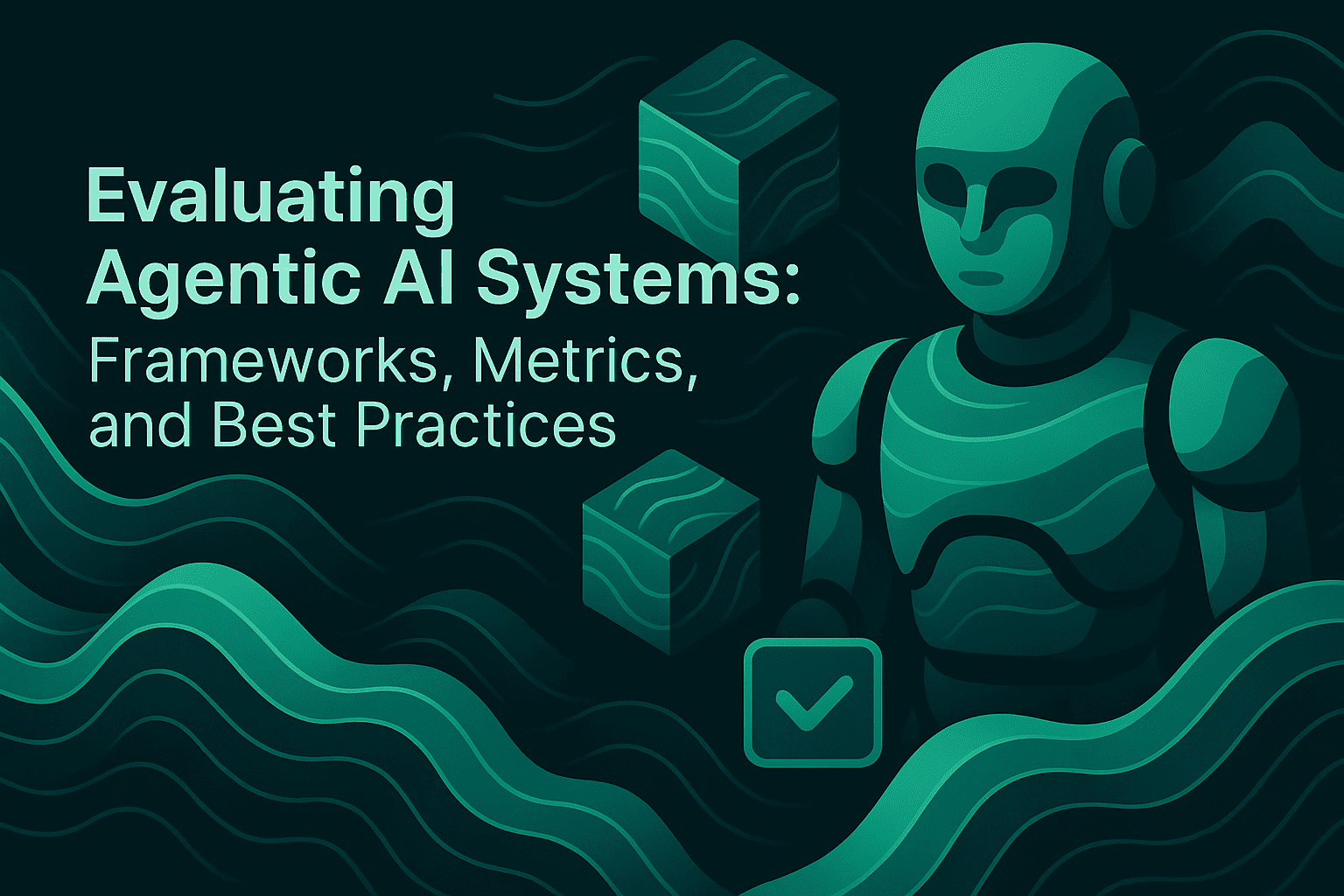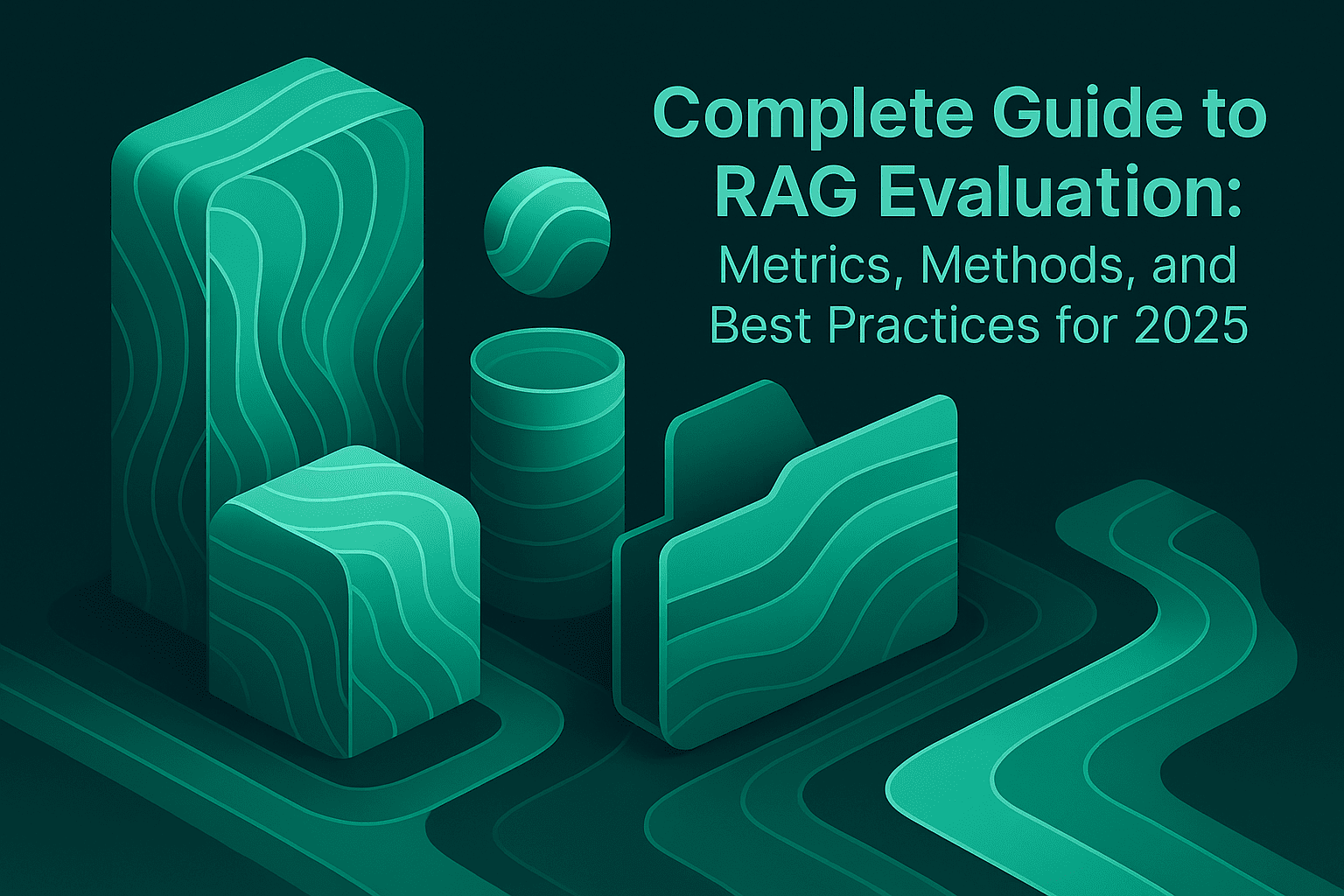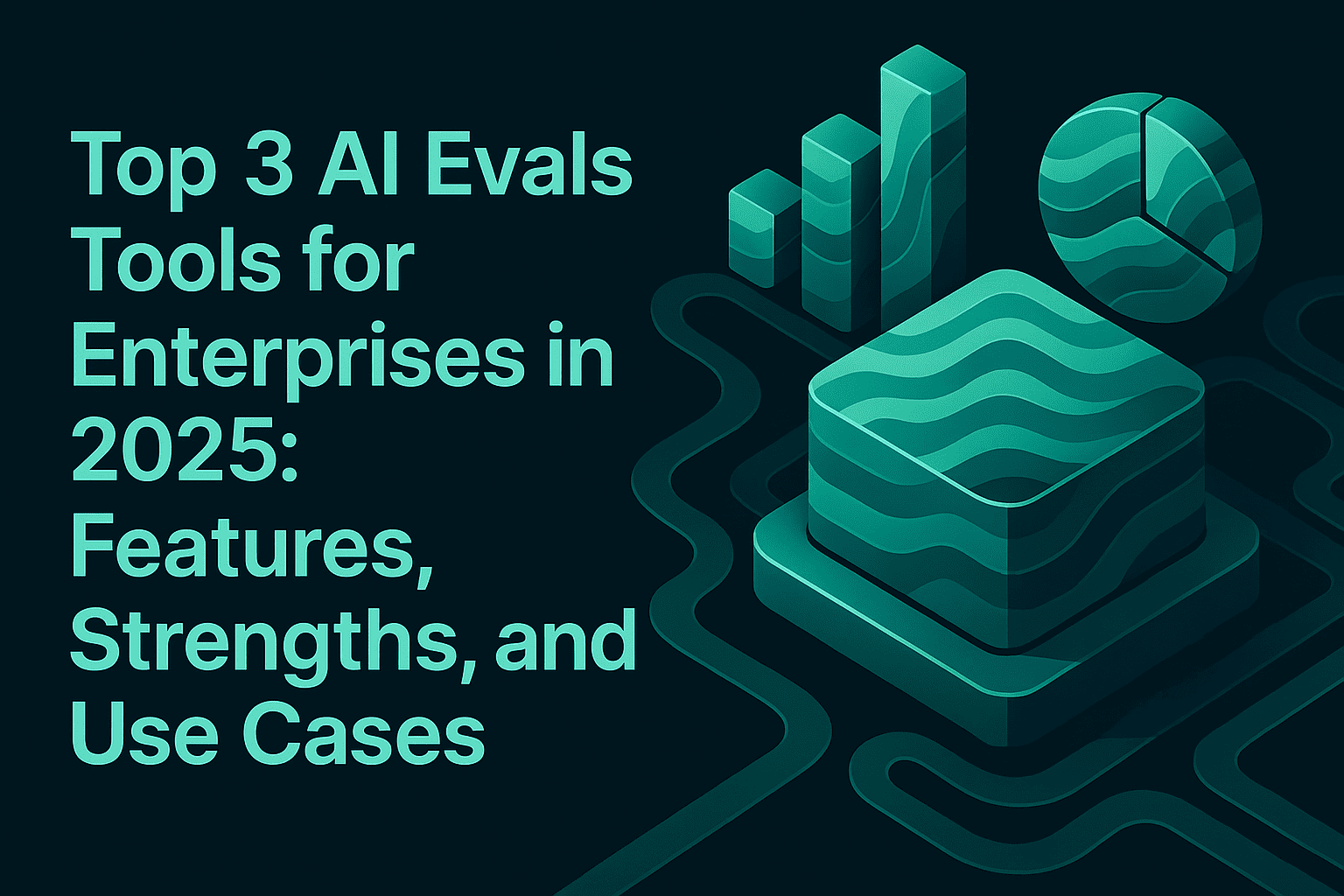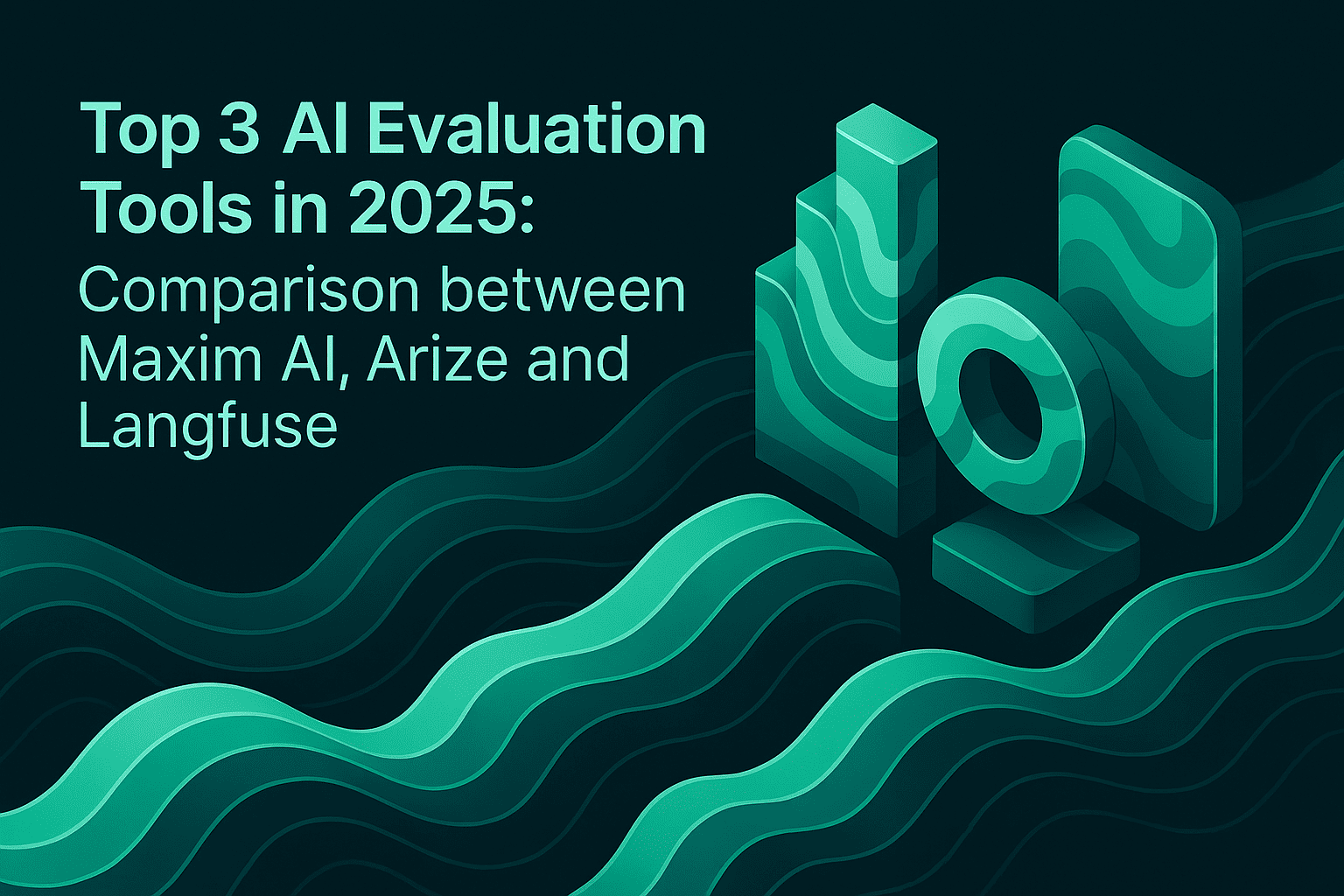Evaluating Agentic AI Systems: Frameworks, Metrics, and Best Practices

TL;DR
Agentic AI systems require evaluation beyond single-shot benchmarks. Use a three-layer framework: System Efficiency (latency, tokens, tool calls), Session-Level Outcomes (task success, trajectory quality), and Node-Level Precision (tool selection, step utility). Combine automated evaluators like LLM-as-a-Judge with human review. Operationalize evaluation from offline simulation to online production monitoring with observability, alerts, and continuous dataset curation. Apply context-specific metrics for RAG, voice, and copilot systems to ensure reliable, scalable AI workflows.
Agentic AI systems plan, reason, and act across multi-step workflows with dynamic context, tool usage, and memory. Evaluating these systems requires more than single-shot benchmarks. It demands a layered approach that captures end-to-end goal completion, intermediate decision quality, and infrastructure efficiency under realistic scenarios. This article presents a comprehensive framework for agent evaluation, the core metrics that matter, and operational best practices teams can adopt to ship reliable, trustworthy AI at scale.
What Makes Agent Evaluation Distinct
Agents are not just models; they are systems that orchestrate multiple components, including planning strategies, tool calls, retrieval operations, and memory. Effective evaluation spans:
- Session-level outcomes that reflect task success and trajectory quality.
- Node-level precision that isolates tool selection, parameter correctness, and step utility.
- System efficiency that ensures scalable latency, cost, and throughput.
Evaluating agent behavior across dynamic, multi-turn environments benefits from multi-level assessment. This approach combines automated evaluators with human review inside repeatable pipelines. A unified approach to online evaluation helps teams continuously monitor sessions, trace, and span-level quality in production. This enables targeted improvements without guesswork. Integrations for observability and alerts further ensure deviations and regressions are caught early, before they impact users. Configure multi-level online evaluations and alerts inside production pipelines to maintain quality across sessions, traces, and spans using online evaluation concepts.
A Layered Evaluation Framework for Agentic Systems
A practical framework organizes evaluation into three layers. Each layer addresses a distinct concern and has specific metrics that quantify behavior and quality.
1) System Efficiency
System efficiency ensures agents remain reliable and performant as usage scales.
- Completion time and latency by step: Measure total time and per-step latency to locate bottlenecks across planning, retrieval, tool calls, and response generation. Latency spikes often indicate inefficient planning loops or redundant calls.
- Token usage across orchestration: Track tokens consumed during planning, tool orchestration, and final responses to control cost while preserving quality. Elevated planning tokens may indicate over-exploration or poor termination criteria.
- Number and success rate of tool calls: Count total invocations and compute success versus error rates. Unnecessary or failing calls are a common source of latency, cost, and downstream failures.
- Throughput and concurrency: Validate agent behavior under concurrent sessions. Monitor saturation points across retrieval indices, gateways, and tool APIs to ensure graceful degradation.
Instrumenting these metrics inside distributed tracing provides visibility from high-level conversations to individual spans. This allows teams to pinpoint the root cause of slow or expensive interactions. Align system-level metrics with agent outcomes through unified dashboards that analyze latency, tokens, and call patterns alongside quality scores using agent observability.
2) Session-Level Outcomes
Session-level evaluation focuses on whether the agent achieved the user's goal and how it progressed across steps.
- Task success: Define clear acceptance criteria for each scenario. For support agents, success may include verified resolution steps and explicit confirmation. For workflow automation, it may include the completion of authenticated actions with correct parameters.
- Step completion and conformance: Assess whether the agent followed the expected plan without skipping critical steps or introducing unnecessary ones. Deviations often signal planning defects or misaligned policies.
- Agent trajectory quality: Evaluate the path taken across turns for coherence, loop avoidance, and recovery from failures. Repeated search-summarize loops, for example, indicate weak stopping criteria or miscalibrated tool selection.
- Self-aware failure rate: Track explicit acknowledgments of inability or constraints, such as rate limits or permission errors. This separates capability gaps from silent failures and informs targeted remediation.
Session-level evaluators combine structured rubrics with multi-turn context to capture the agent's decision chain and end-to-end reliability. Teams can operationalize these checks for both offline test suites and online production logs with scenario-driven setups using evaluation workflows.
3) Node-Level Precision
Node-level evaluation isolates quality at the span level for each action in the workflow.
- Tool selection: Verify that the agent chose the correct tool for the task with suitable parameters. Scoring should consider domain-specific rules and provide reasons for selection quality.
- Tool call error rate: Monitor connectivity, schema mismatches, and parameter errors. Rising HTTP 4xx responses from knowledge APIs often cascade into downstream failures and must trigger alerts.
- Tool call accuracy: Compare outputs against ground truth or reference constraints when available, such as SKU filters, permission scopes, or retrieval relevance for RAG systems.
- Plan evaluation: Score planning quality against task requirements. Plans that skip authentication or omit validation steps represent high-severity faults and require immediate correction.
- Step utility: Assess each step's contribution to the final outcome. Prune non-contributing actions to reduce tokens and latency without harming success rates.
Node-level checks power precise debugging by linking evaluator scores to spans inside traces. This makes the causes of failure obvious to engineering and product teams. Applying evaluators to specific components of a trace aligns improvement efforts with the highest impact areas using span-level evaluation.
LLM-as-a-Judge for Scalable, Nuanced Evaluation
LLM-as-a-Judge is an automated evaluation technique where a language model applies a rubric to score outputs on dimensions such as relevance, factual accuracy, coherence, and safety. It enables scalable, nuanced assessments with rationales, complementing deterministic and statistical checks. Teams can tailor rubrics for domain requirements, calibrate judges against human annotation, and use multi-model ensembles to mitigate bias. This approach accelerates iteration by turning subjective criteria into repeatable signals. It can be embedded throughout the lifecycle, from simulation runs to production monitoring using LLM-as-a-Judge evaluation.
From Offline to Online: Operationalizing Agent Evaluation
A robust pipeline spans pre-release and production.
- Scenario generation and simulation: Define personas, environments, and constraints. Simulate multi-turn conversations to uncover trajectory defects, weak recovery strategies, and brittle tool selection. Re-run simulations from specific steps to reproduce issues and test fixes at the exact failure points using multi-turn simulation datasets.
- Evaluator composition: Combine deterministic rules, programmatic checks, statistical tests, and LLM-as-a-Judge. Use binary pass/fail for critical guardrails and scaled scoring for nuanced attributes such as helpfulness or faithfulness.
- Human in the loop: Conduct expert reviews for subjective or high-stakes tasks. Periodically calibrate automated judges against human annotation to maintain reliability and fairness in changing contexts.
- Observability and alerts: Instrument distributed tracing across sessions, traces, and spans. Configure filters and sampling rules to run online evaluations on production logs and trigger alerts for anomalies, latency spikes, and policy violations using alerting and monitoring.
- Dataset curation: Continuously evolve test suites with production logs, failure samples, and human feedback. Create targeted splits for regression tests, stress tests, and domain-specific compliance checks using dataset curation workflows.
Best Practices for Trustworthy AI Evaluation
Adopt practices that improve reliability while scaling confidently.
- Define precise acceptance criteria: Write scenario-specific success definitions and plan conformance rules. Tie every metric to an operational decision, such as approval to deploy or rollback triggers.
- Evaluate trajectories, not only outputs: Multi-turn agents need trajectory evaluation to catch loops, missed steps, and poor recovery. Treat plan quality as a first-class signal, not just the final response.
- Balance automation with expert judgment: Use automated evaluators for scale and speed. Apply human review for complex domains, compliance, and last-mile approvals.
- Measure and guard for safety: Integrate policy adherence checks, bias detection, and hallucination detection across evaluators. Include adversarial testing for prompt injection and jailbreaking to protect production systems.
- Align efficiency with quality: Track latency, tokens, and tool calls alongside task success and trajectory scores. Optimize only when quality is preserved. Otherwise, document trade-offs explicitly.
- Close the loop in production: Run periodic quality checks on live logs with targeted sampling. Use alerts for drift and regressions to protect user experience and maintain service-level commitments.
Applying the Framework to RAG, Voice, and Copilot Systems
Agentic systems vary by modality and environment. The same layered evaluation applies with context-specific metrics.
- RAG systems: Emphasize retrieval relevance, faithfulness to sources, and hallucination detection. Node-level checks should score chunk selection, context assembly, and citation completeness. Session-level outcomes assess whether users received correct and well-sourced answers. Routing retrieval and generation traces into evaluators enables precise rag tracing and rag evaluation inside production workflows using retrieval testing methods.
- Voice agents: Add voice observability for ASR accuracy, latency across capture and synthesis, and turn-taking integrity. Node-level checks score intent resolution and tool selection from spoken input. Session-level outcomes focus on resolution rates and corrective strategies. Voice evaluation should include error handling for noisy input and domain-specific disambiguation using voice tracing and evaluation.
- Copilot-style assistants: Stress prompt management, prompt versioning, and agent monitoring for IDE or app-integrated workflows. Track plan utility for suggestions and tool use, including file operations or API calls. Evaluate agent debugging performance by replaying failure traces and annotating step utility with reasons using prompt comparison and version control.
Implementation Checklist
Use this concise plan to launch a strong evaluation program.
- Define scenario-specific acceptance criteria and step conformance rules.
- Build simulation datasets with personas and edge cases. Include adversarial patterns.
- Compose evaluators across deterministic rules, programmatic checks, statistical tests, and LLM-as-a-Judge.
- Instrument observability with distributed tracing. Enable online evaluations on production logs.
- Configure alerts for anomalies, latency spikes, policy violations, and trajectory regressions.
- Curate datasets from evaluated logs. Maintain targeted splits for regression and stress testing.
- Calibrate automated judges against human annotation. Document changes and revalidate.
Conclusion
Evaluating agentic AI systems requires layered, scenario-driven methods that quantify planning, reasoning, and action reliability. System efficiency metrics keep latency and cost in check. Session-level outcomes validate end-to-end goal completion and trajectory quality. Node-level precision pinpoints root causes for rapid debugging. Combining simulation, evaluators, human review, observability, and online monitoring builds a continuous loop that improves reliability, compliance, and user outcomes. For security and resilience, incorporate safeguards against prompt injection and jailbreaking, enforce policy checks, and operationalize evaluator gates throughout the lifecycle.
Ready to validate and scale agentic workflows with confidence? Get started with Maxim.


